You imagined it vividly. The magnificent multi-level cat tree arrives. You put it together in an hour, securing each platform and tightening every bolt. Admiring your work, you take a step back and show it to your furry master.
Your cat looks at the magnificent tower for a moment, sniffs it with disapproval, and immediately curls up in the cardboard box it came in. While the box becomes the hottest piece of real estate in the house, the pricey new furniture sits in the corner and gathers dust.
If you’re wondering how to get your cat to use the cat tree, you’re not alone. Fortunately, you can overcome this problem. You only have to think about how a feline behaves.

Before you can figure out how to get them to use it, you need to know why your cat is ignoring the cat tree. Cats are suspicious and habitual creatures. A big, new thing in their territory can make them feel scared instead of welcoming. It’s not personal that they don’t want to use the tower; it’s more of an instinctual thing.
The smell is one of the reasons. New furniture, especially pieces made of wood, glue, and synthetic fabrics, has a strong, unfamiliar smell. You, your cat, and everything else in your home makes up its own “scent profile.” This new tree doesn’t smell like a safe part of their kingdom, but more like a factory.
A cat’s sense of smell is highly sensitive, and a new smell can make them not want to be around the area. They won’t even think about claiming the tree as their own until it smells like home.
Instability is another common problem. Your cat will probably think the cat tree is unsafe and never go near it again if it wobbles even a little when they jump on it. A shaky, wild branch is a dangerous branch. Your cat’s instincts tell them to look for high, stable places to sit.
A wobbly cat tree feels like a trap. They need to feel safe so they can relax and enjoy the view from their new lookout point. To get cats to use cat trees, the first step is to check if they are sturdy and in the right place.
Finally, think about the design and location. Is the tower too small for your cat? Are the perches awkward to access?
You also have to consider its placement. Cats are friendly animals that enjoy spending time with others, but they also like to keep an eye on their surroundings. Your cat won’t go to the tree if you put it in a quiet, dusty corner of the room that no one else uses. They want to be involved, even if they can’t see it. Making the cat tower a place your whiskered friend wants to go is the first step in getting them to use it.

Choosing the right cat tree is half the fight—shop based on your cat’s unique personality, not just the one that complements your décor. You can get all the information you need by watching how your cat behaves.
Consider your cat’s habits before making a purchase.
Stability is non-negotiable. Look for a tree with a large, heavy base. The loftier the structure, the broader the base should be. When you’re at the store, make sure to shake it well. If it wobbles for you, it will wobble for your cat. The best way to get a cat to use a cat tree is to ensure it feels safe and secure from their very first leap.
The materials matter, too. Sisal is the best option for scratching poles. For lounging surfaces, soft carpet or faux fur is usually a big hit. Avoid trees with a lot of chemically treated materials or strong odors, as this can be a serious deterrent. Choosing the right cat tree can significantly ease the process of getting your cat to use it.
Once you have the perfect, stable cat tree, it’s time for the formal introduction. You can’t just set it up and expect your cat to jump for joy. You need a strategy.
It’s where you put your “think like a cat” skills to the test. Your goal is to make the cat tree the most appealing object in the room.
Here are some proven methods you can use.
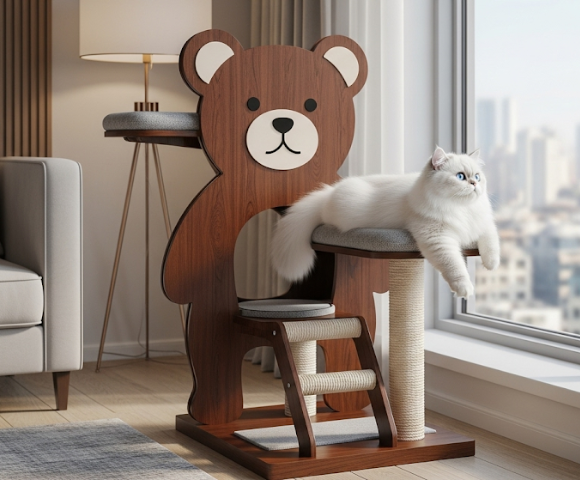
Where you place the cat tree can make or break your success. Don’t hide it in a spare room. Put it where the action is, such as in the living room, where everyone relaxes and spends time together, or near a window so your cat can enjoy watching the birds and squirrels outside.
Cats are curious and a little bit nosy—they love to keep an eye on their territory. When placed in the right spot, a tree can transform a simple piece of furniture into a fun entertainment center.
Put the tree where your cat likes to nap, like near the sunbeam, if that’s where they like to sleep. If you want to know how to get your cat to use the cat tree well, associating it with a place your cat already loves is a great way to do it.
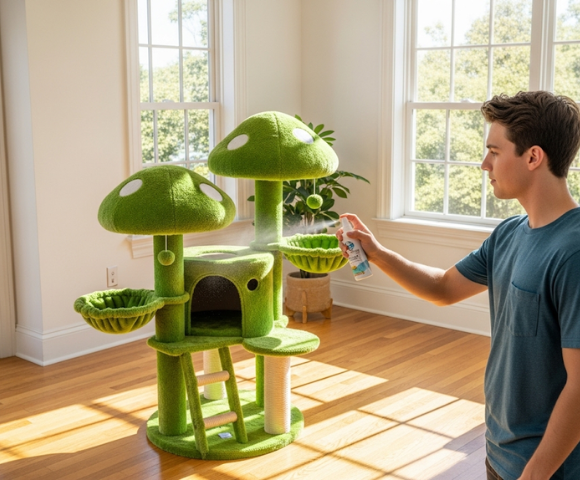
To counteract the new-product smell, you need to make the tree smell familiar and safe. Take a blanket or t-shirt that you or your cat has used and rub it all over the tree, especially on the perches and inside any condos. This tactic transfers their scent and your scent onto the tree, marking it as part of the family’s territory.
You can also use catnip. You can either spray catnip mist or sprinkle dried catnip on the different levels. Catnip makes most cats feel happy, helping them connect the tree with positive things. To get cats to use cat tree products, you often have to appeal to their strong sense of smell.
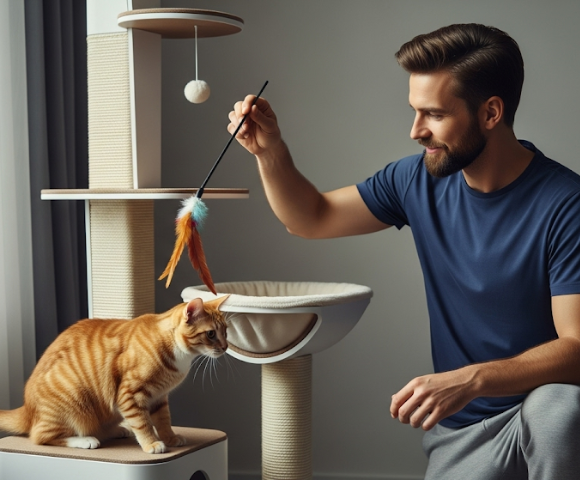
Never force your cat onto the tree, as it will only create fear and negative associations. Instead, use encouragement and rewards. Lure them onto the tree with their favorite toys. Dangle a feather wand over the lowest perch and encourage them to jump up to catch it. If you spot them using it, give them a treat and commend them.
Lead them up to each tree level by using toys or treats to turn the structure into a fun playground. The most successful strategy for getting a cat to use a cat tree involves making them think it was their idea all along. Play with them on and around the tree daily.
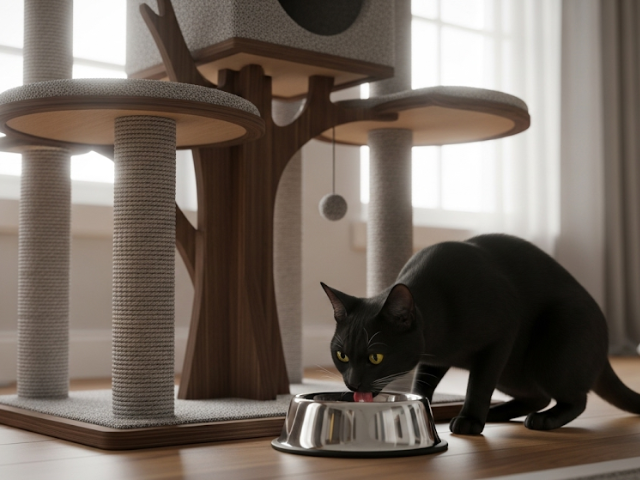
If the basic introduction isn’t working quickly enough, don’t fret. Some cats are more cautious or tenacious than others. It may be necessary for you to employ a few additional strategies.
To answer your curiosity about “how to get my cat to use the cat tree,” you need to think creatively.
One of the most effective tools is a laser pointer. Most cats find the little red dot irresistible. Start playing with your kitty on the floor near the tower. Gradually move the dot onto the base of the tree, then up onto the first platform.
Let your cat chase it. Take things slowly. Let them become accustomed to each level before raising the dot. This method works well because they are so focused on their “prey” that they forget to be nervous about the new object.
You can also use feeding time to your advantage. If your cat is highly food-motivated, try placing their food bowl near the base of the cat tree. Once they are comfortable eating there, move the bowl onto the first platform. They may be hesitant at first, but hunger will usually win. It’s a temporary measure, but it can be a fantastic way to build that initial positive association. This tip is invaluable when attempting to teach a cat to use a cat tree.
Never undervalue the impact of praise. Praise your cat with a cheerful, kind voice whenever you catch them even sniffing the tree or rubbing up against it. Tell them they are making progress. This encouraging comment supports the notion that the tree is a pleasant and secure location. The secret to success lies in combining these strategies.
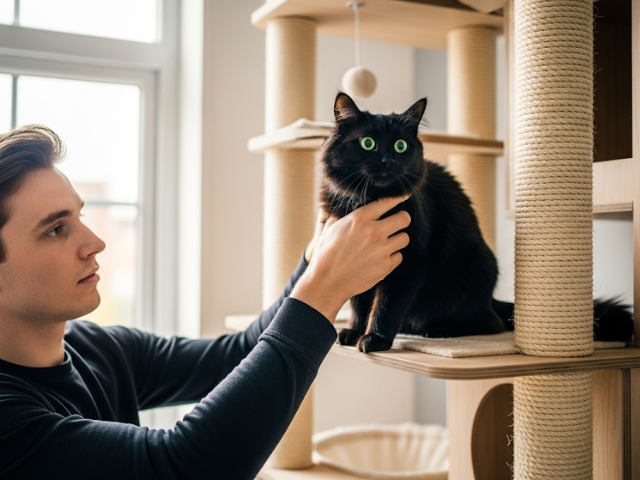
Learning how to get your cat to use the cat tree is just as important as knowing what not to do. Some well-planned tactics can make your cat even more resistant to their new towering playground. Avoiding these common mistakes is crucial if you want to encourage your cat to use the cat tower without setbacks.
The most unfavorable thing you can do is to place your whiskered baby in a tree by yourself. It’s startling and removes their sense of control. They will feel trapped and may leap off, potentially hurting themselves and solidifying their fear of the tree. Your job is to entice, not to force. Any method that involves force will fail.
Don’t punish your cat for not using the tree or scratching other things. Punishment will only cause stress and anxiety in your cat, making them feel less at ease or adventurous. If you see them scratching the couch, though, just pick them up and put them next to the scratching post on the cat tree. When they use it, reward them. Redirect bad behavior instead of punishing it.
Another mistake is getting rid of their old, tattered scratching post too soon. That old post is soaked in their scent and feels safe. Keep it around while you are introducing the new tree. You can place it next to the new tree to help transfer the “good” scent. Once you see them regularly using the new tree, you can quietly remove the old one.
The best approach for getting cats to use the cat tree structures is gradual and patient. Giving up too early is the final mistake. It can take some cats weeks or even a month to get them used to a new cat tree.
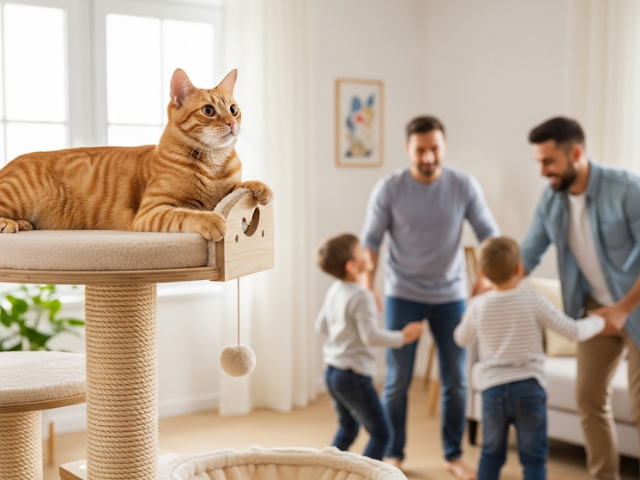
Everything you did was correct. You purchased the ideal tree, placed it in the best location, and stocked it with catnip and treats. However, your feline still favors the sofa arm. While it can be frustrating, patience is your most valuable tool.
You manage your cat’s agenda, not the other way around. You will only become more stressed if you keep asking yourself, “Why won’t my cat use the cat tree?” Have faith in the process.
Continue to provide positive reinforcement. Include playing on and near the tree in your everyday activities. Let them explore on their own by leaving treats on various levels. The idea is to make the tree complement your home interior so well that your cat will see it as a natural part of the space.
All your efforts will have been worthwhile when you eventually enter the room and find them soundly dozing on the top perch. It’s the best reward as a cat owner.
It takes more empathy and perseverance than a magic trick to figure out how to get your cat to use the cat tree. By demonstrating to your cat that this new addition is a fantastic, safe, and entertaining space exclusively for them, you are building trust. It’s a way to make them happier and healthier.
There is more to a cat tree than just climbing. It fulfills their innate desires to perch, scratch, and feel safe. Giving them this outlet improves their quality of life, lowers stress levels, and may even save your furniture.
You and your pet will go on a journey to learn how to get your cat to use the cat tree. Together, you will find fun ways to make the cat tree a favorite place for your pet. It deepens your relationship and demonstrates your concern for them. Don’t give up on that lonely, lovely cat tree, then. It will quickly become your cat’s favorite part in the entire house with a lot of love and a little time.

